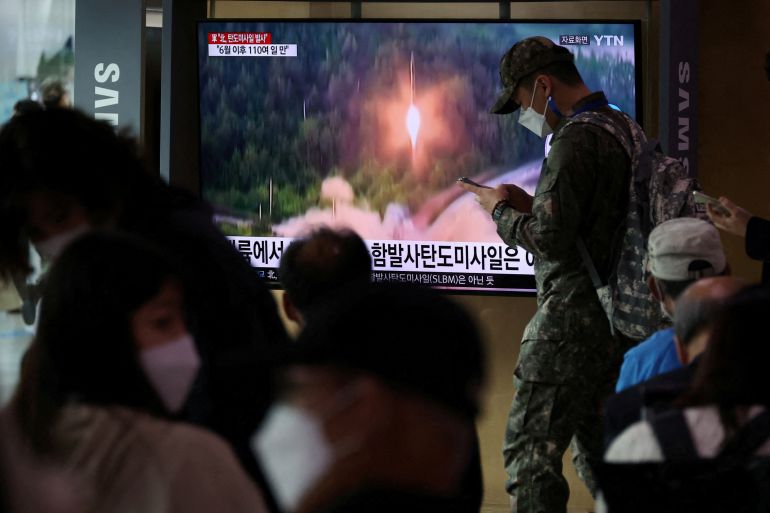North Korea fires two missiles after US-South Korea drills
Pyongyang’s seventh weapons test in two weeks comes as it prepares to celebrate the ruling party’s founding day.

North Korea has fired two short-range ballistic missiles towards the eastern waters of the peninsula — the seventh launch in two weeks of weapons tests after South Korea and the United States concluded their latest round of naval drills.
South Korea’s Joint Chiefs of Staff said Pyongyang fired the two missiles from the southeastern coastal city of Munchon early on Sunday. The first was fired at about 1:47am local time (16:47 GMT) and the second one some six minutes later.
Keep reading
list of 4 itemsWhat’s behind North Korea’s latest missile tests?
US aircraft carrier in new drills as North Korean tension simmers
Would N Korea really test a nuclear bomb during China Congress?
The Japanese government also said North Korea had fired what appeared to be ballistic missiles.
The two missiles reached an altitude of 100km (60 miles) and covered a range of 350km (217 miles), Japan’s State Minister of Defence Toshiro Ino told reporters.
Both fell outside Japan’s exclusive economic zone, and authorities were looking into what kind of missiles were launched, including the possibility that they were submarine-launched ballistic missiles, he said.
South Korea’s military condemned the launches as a “serious provocation” that undermined peace, noting they were a “clear violation” of UN Security Council resolutions.
The US Indo-Pacific Command said in a statement that it was discussing the situation with its allies and partners, and highlighted the “destabilizing impact” of North Korea’s nuclear arms and ballistic missile programmes. It reiterated that the US commitment to the defence of South Korea and Japan remained “ironclad”.
‘Righteous reaction’
North Korea has carried out an unprecedented number of weapons tests this year, including its biggest-ever intercontinental ballistic missile (ICBM), as North Korean leader Kim Jong Un steps up efforts to modernise and expand the country’s military capabilities.
The most recent launches have taken place around military exercises held by the US, South Korea and Japan, with naval drills involving the nuclear-powered aircraft carrier USS Ronald Reagan wrapping up on Saturday.
Sunday’s launch also came on the eve of the 77th anniversary of the founding of North Korea’s ruling Workers’ Party, a major event for Pyongyang.
On Saturday, North Korea’s defence ministry warned that the redeployment of the 103,000-tonne Ronald Reagan, which was sent back to the seas around the Koreas after Pyongyang fired a powerful missile over Japan, was causing a “considerably huge negative splash” in regional security.
It said its recent missile tests were a “righteous reaction” to the military drills by its rivals.
“Our missile tests are a normal, planned self-defence measure to protect our country’s security and regional peace from direct US military threats,” said state media KCNA, citing an aviation administration spokesperson.
North Korea regards US-South Korean military exercises as a rehearsal for invasion and is especially sensitive if such drills involve US strategic assets such as an aircraft carrier.
North Korea has argued it was forced to pursue a nuclear weapons programme in response to US “hostility” and necessary for self-defence.
US and South Korean officials have repeatedly said they have no intention of attacking North Korea.
Take cover
The intermediate-range ballistic missile that was tested on Tuesday flew over Japan for the first time in five years, demonstrating sufficient range to attack the US Pacific territory of Guam and beyond.
Earlier tests have involved weapons that place the US mainland and its allies South Korea and Japan within striking distance, as well as new solid-propellant short-range ballistic missiles (SRBMs).
— Ankit Panda (@nktpnd) October 8, 2022
Analysts said that while the tests suggested North Korea’s conventional warfare capabilities were improving, and that it was better positioned to dissuade US escalation in a provocation or conflict initiated by Pyongyang or in the event of a US-led attack on North Korea, the military and strategic situation on the peninsula had not changed fundamentally.
“Despite North Korea’s missile threat to the US homeland and improving conventional SRBM capabilities, the US-ROK [South Korea] alliance is still able to deter North Korea — just as the US and its allies successfully deterred the Soviet Union under conditions of US conventional inferiority and nuclear parity,” WMD expert Vann H Van Diepen wrote in an assessment for the Stimson Center’s 38 North.
“Maintaining this deterrence, however, will require continued efforts to uphold US military and political credibility, alliance solidarity and South Korean and Japanese conventional military capability.”
North Korea is struggling under tough sanctions imposed after its last nuclear test in September 2017.
Denuclearisation talks have been stalled since Kim walked out of a second summit with former US President Donald Trump in 2019 over sanctions relief.
Unusually, North Korean state media has not yet released any photos or video of the recent launches.
Analysts say it is preparing to carry out a nuclear test with South Korea predicting it could take place as soon as this month.